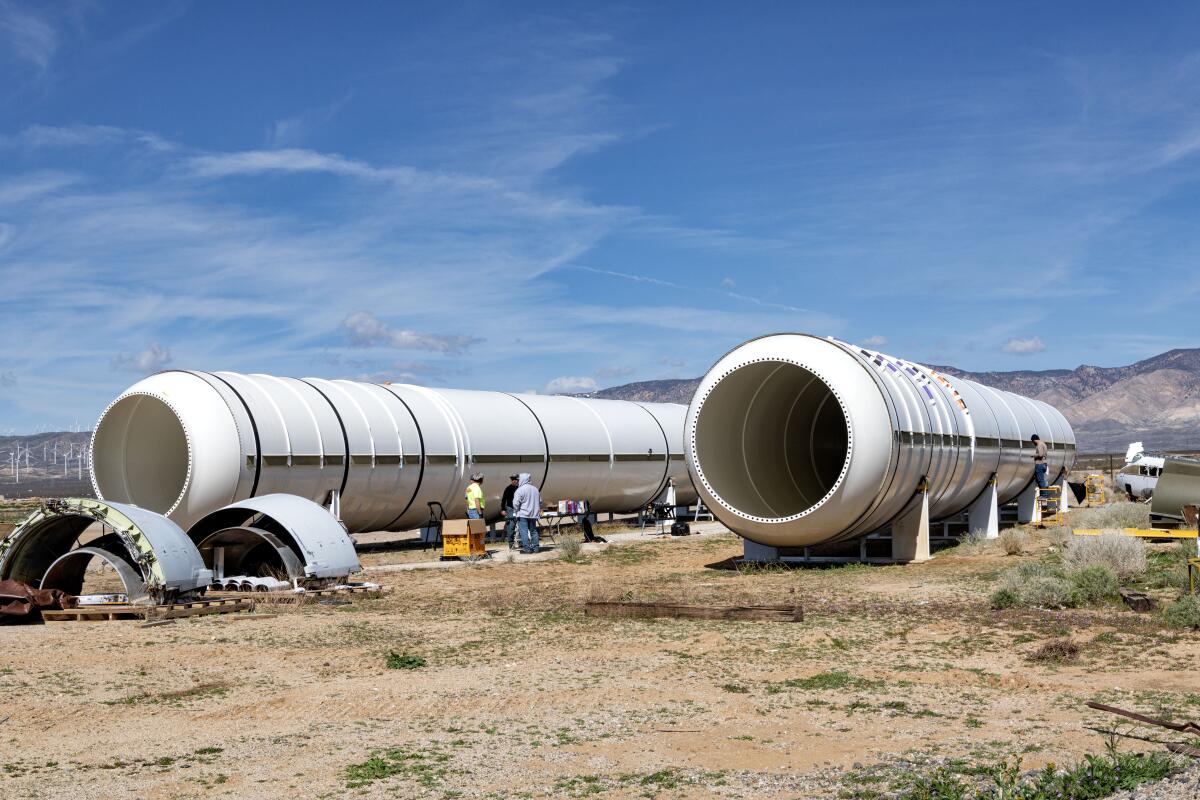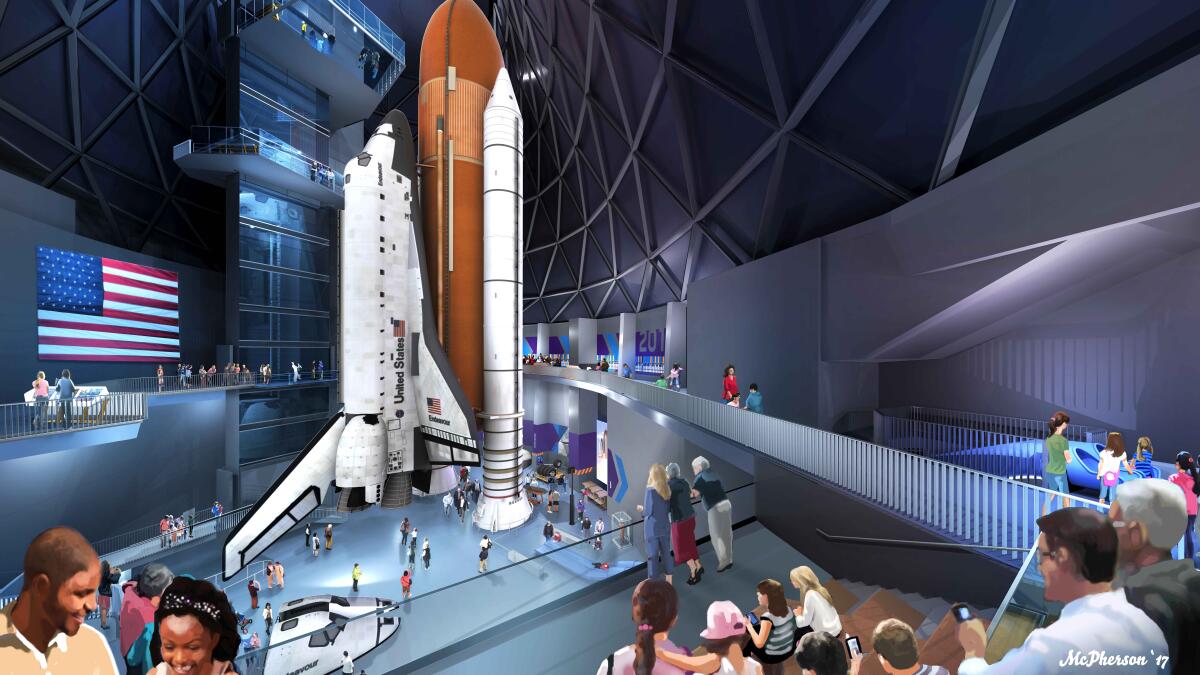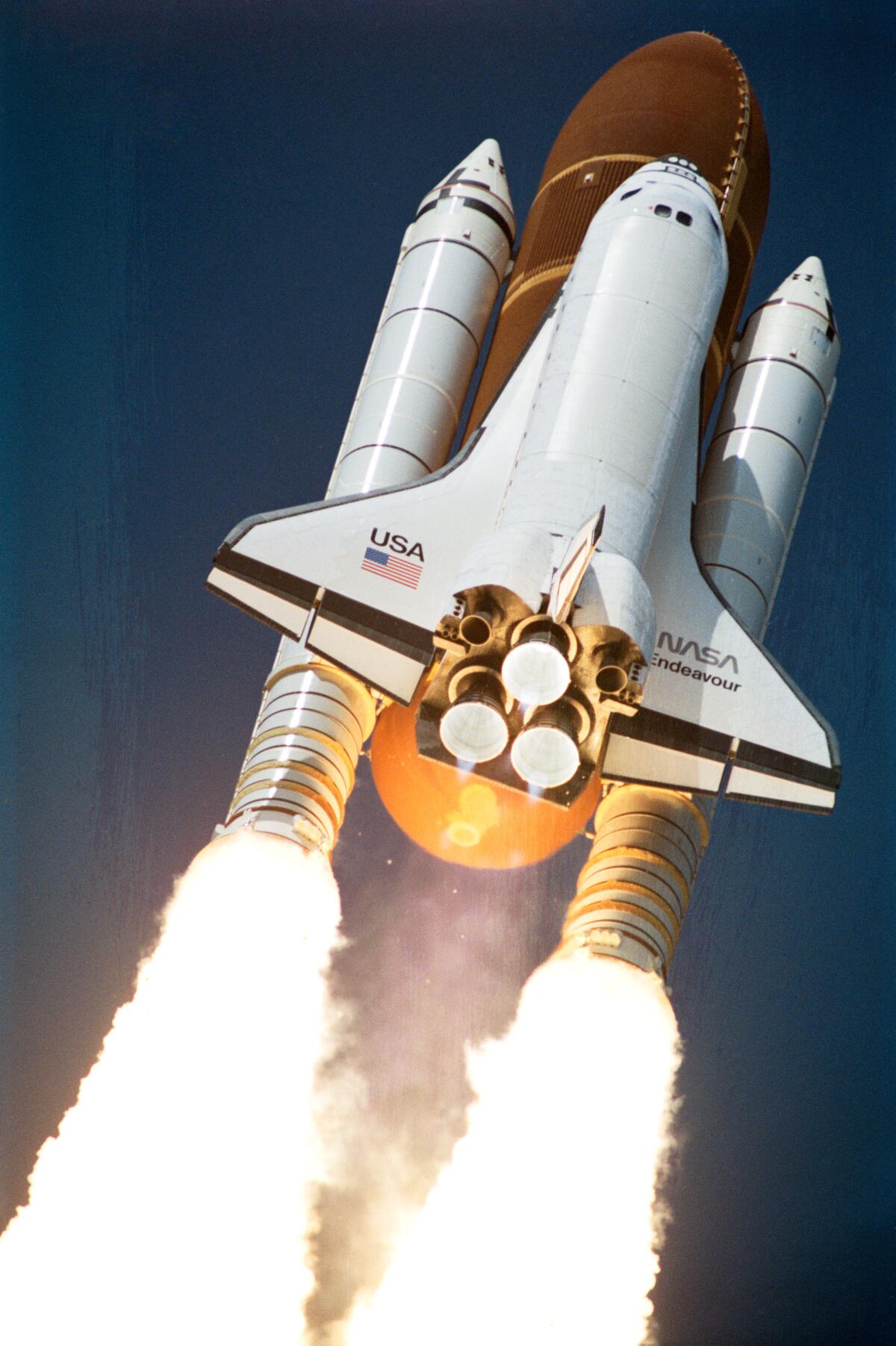Space shuttle’s rockets will be trucked through SoCal roads Tuesday and Wednesday

- Share via
Get ready for the last big transport of space shuttle equipment to the California Science Center, a two-day spectacle that will traverse seven freeways from the Mojave Desert to South Los Angeles, to be eventually installed at a grand 20-story museum exhibit.
This will be the final large piece of equipment needed as the California Science Center constructs the $400-million Samuel Oschin Air and Space Center, the final museum home of the space shuttle Endeavour, which is being assembled as if it’s being prepared for launch. The new museum wing has been anticipated since 2011 when NASA chose the science center as one of just three museums nationwide to permanently feature the trio of surviving shuttles that have seen spaceflight.
When the final exhibit is fully built, Endeavour will be the only space shuttle that will be exhibited as if it is being launched. Endeavour will be moved from its temporary hangar and hoisted from a horizontal to a vertical position no earlier than the last week of January.
The journey of the space shuttle equipment this week will take three hours Tuesday morning and six hours Wednesday morning. The move involves twin solid rocket motors, which form most of the white solid rocket boosters. The solid rocket boosters produced more than 80% of the lift during takeoff.
The rocket motors will traverse about 160 miles from their current home at the Mojave Air and Space Port to the California Science Center.

Donated by Northrup Grumman, each solid rocket motor is large — 12 feet, 2 inches in diameter, and 116 feet in length. Each solid rocket motor weighs 104,000 pounds, and each will be transported on its own truck.
“They’re big rockets,” said Jeffrey Rudolph, president of the California Science Center. “And they’re about the diameter of a [Boeing] 757 fuselage, and pretty close to the same length. So that’s why they’re pretty big to move down the streets.
“This is really the last big part of the ‘lift-to-vertical’ that the public can come out and see and participate in.” This week’s move, he said, is the “last chance to see a big part of the shuttle moving through the city.”
The solid rocket motors are wide enough that they’ll take more than one lane of traffic.
But the diameter of the rocket motors is small enough that, when carried on a low truck bed, they’ll be able to fit underneath freeway underpasses along the designated route. That means the journey of this equipment will occur far more easily and faster than the transport of the Endeavour orbiter in 2012 and the orange external tank in 2016.
On the freeways, road closures are not required for the journey; instead, the plan is for the solid rocket motors to be surrounded by escort vehicles and California Highway Patrol cars. The speed of the rocket motors will generally be 45 mph on the freeways.

The rocket motors will begin departing the Mojave Air and Space Port at 9 a.m. Tuesday, exiting south on Airport Road, then east on Mojave-Barstow Highway, and then continuing to Route 58.
Then the rocket motors will head south on U.S. 395, then south on Interstate 15 through the Cajon Pass. Once in Rancho Cucamonga, the rocket motors will head west on the 210 Freeway and head toward Irwindale, where they’ll head south on the 605 Freeway and arrive at some location around noon Tuesday. The rocket motors will remain in place at a location beside the freeway for about 15 hours; they will not be blocking traffic and the exact location wasn’t disclosed.
Then Wednesday at 3 a.m., the journey will resume. The rocket motors will head south on the 605 Freeway. After arriving in Norwalk, the rockets will head west on the 105. They’ll then turn north on the 110 Freeway, and about 5 a.m., exit at Gage Avenue, heading east before heading north on Broadway.
The rocket motors will then take a left on Slauson Avenue, going underneath the 110 Freeway, before making a right on Figueroa Street. At 7:30 a.m., the rocket motors are expected to head north on Figueroa Street, starting at West 43rd Place, and continue on for about two miles before arriving at the California Science Center.
The rocket motors are expected to pause at 8 a.m. at Figueroa Street and Martin Luther King Jr. Boulevard. At 8:45 a.m., they’re expected to pass through a ceremonial finish line at Figueroa and 39th streets, and at 9 a.m., will turn left onto State Drive and finally arrive at the California Science Center.
“People can come out and be on the sidewalks and watch,” Rudolph said; the museum said the public is invited to gather along Figueroa Street from West 43rd Place to 39th Street. The California Science Center will also open its doors an hour early on Wednesday, at 9 a.m., so that spectators can come in as soon as the solid rocket motors arrive.
The closest Metro rail stop to the California Science Center is at the Expo Park/USC station along the “E” light rail line, previously known as the Expo Line. Parking will also be available in the museum’s Blue parking structure, but motorists should enter through the entrance at Hoover Street and Martin Luther King Jr. Boulevard.
There will be rolling road closures on city streets once the rocket motors exit the 110 Freeway.
After Endeavour’s arrival in 2012, the orbiter has been on display in the temporary Samuel Oschin Pavilion, essentially a warehouse where it has been viewed over the last decade, and where it will be shown until Dec. 31. After that date, it could be years before Endeavour will again be available for up-close viewing by museum guests.
In mid-2022, the California Science Center broke ground on the new permanent museum, and three months ago, construction crews began installing the base of the shuttle’s full stack. They installed the bottom section of the solid rocket boosters, known as the aft skirts — which are 9 feet long — that will support the solid rocket motors being transported across Southern California this week.
Once the solid rocket motors are installed, the tip of the rockets — the 27-foot “forward assembly,” which includes the nose cone and the forward skirt — will be installed next. When the solid rocket boosters are fully assembled, they will be roughly 149 feet in length, and each will weigh about 130,000 pounds.
That will set the stage for the installation of the orange external tank, no earlier than early January, followed by the installation of Endeavour.
More to Read
Sign up for Essential California
The most important California stories and recommendations in your inbox every morning.
You may occasionally receive promotional content from the Los Angeles Times.














